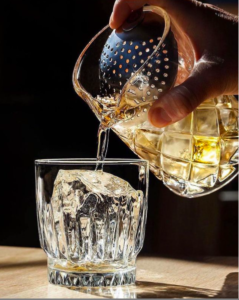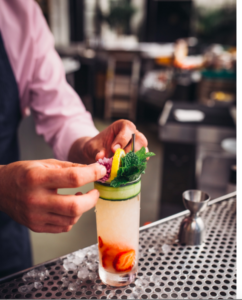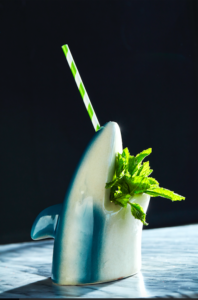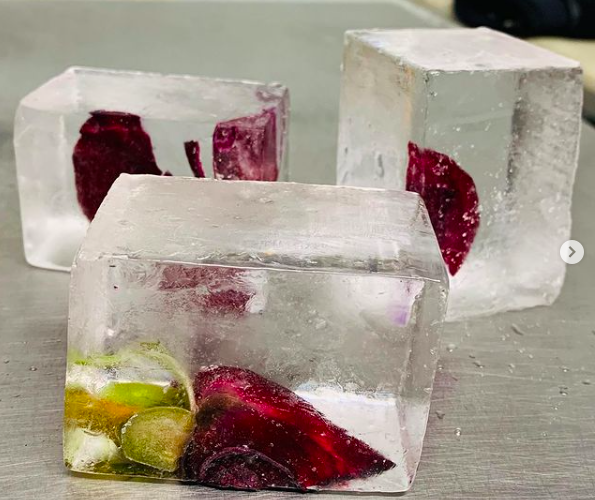I have heard the stories of cocktails gone wrong – so very wrong. It’s been almost a year, and you thought you’d get better at it, but it still doesn’t taste as good as when you go to a bar or restaurant. You have tried to reverse engineer your favorite drinks but it still isn’t panning out.
COVID-stress, home-schooling, another Zoom meeting, general boredom, loneliness – you want a cocktail. So you have at it with ingredients on hand: freezer burned ice cubes, strange liquor that you found in the back of your bar, a sad lime from the fruit basket, a fresh squeezed juice meant to be a breakfast smoothie. These ingredients collide into a disaster on your palate. More dedicated types are squeezing their own juice and sourcing cool booze choices, but are still disappointed with the results and with good reason – professionals have tricks.
I reached out to some of your favorite bartenders to find out why exactly cocktails at home do not measure up to those you get at your favorite watering hole.

Courtesy Penny Pound Ice
You would be surprised to know that nearly every person I spoke to mentioned that measuring and using the proper tools were the most crucial things. If you buy nothing else, invest in a jigger. For those who don’t know, it is a multi-purpose measuring tool for all of the components in a drink and every bartender has a favorite type. When making drinks at home, many amateur mixers put in ice, eyeball the pour for the amount of alcohol and then add the mixer. Not only are you usually over-pouring the booze and hence shortening your night and increasing your hangover, you are likely throwing off the flavors. As you work with more intricate recipes, the jigger becomes more and more important to striking the perfect balance as the difference between 1/4 and 1/2, and 2 and 3 ounces are completely different drinks.
Before you even put the booze in the ice, those in the industry consider the ice itself and its use. Is the ice for shaking or serving? What type of ice will you use? Probably without your knowledge, most cocktail bars and good restaurants are using RO ice (Reverse Osmosis ice reduces contaminants by up to 95%, helps reduce particles, bacteria and dissolved minerals commonly found in tap water. Moreover, it helps to remove some harder-to-detect contaminants that can be harmful to your health, such as lead and arsenic).
However, several places go even further. Eric Alperin, author of Unvarnished, co-founder of The Varnish in DTLA and Penny Pound Ice, realized the importance of ice so much, he started a company to supply bars and restaurants with this commodity years ago and has even pivoted to home supply during the pandemic. Using machines (originally designed for ice sculptors) 300 pound blocks are frozen over the course of three to five days, forcing out impurities and producing cleaner, denser and clearer ice. Human hands then wield chainsaws and bandsaws to turn these massive blocks into smaller, manageable sizes for consumption. This certainly beats the half cubes you dig out of the back of your freezer from those sad trays.

Fountain of Youth (Courtesy Redbird)
Not only is the ice important, but how you use it is equally important. When shaking or stirring a cocktail, are you using enough vigor or, conversely, shaking too long. This impacts the dilution of the drink and overall flavor and temperature. Are you pouring the drink over fresh ice? Is it a big cube, rocks or served off-rocks into a chilled glass? These are considerations and choices made by the pros as they develop recipes and procedures.
Stephanie Reading, Bar Manager of Birdie G’s and consultant at Tallula’s of the Rustic Canyon Group, takes their food ethos through to the cocktail program and relies heavily on farmer’s market produce and micro-seasonality. Her teams juice fresh produce daily and construct syrups and reductions from the at-the-moment availability of what is best at the Santa Monica Farmers market on a given week. This utilization of fresh product and access to obscure ingredients really inspires her and her team to move with the season to create new offerings.
Fresh juices are certainly a game-changer and unfortunately not available at most markets. The alternatives, like sweetened or concentrated juices, frozen purees and shelf stable syrups, are not the same thing.
This fresh produce and other inventive extras are also key to garnishes. Many at-home bartenders forego a garnish. But a garnish can complete the drink, accent the components and add visual intrigue. Garnishes are sliced, chopped, peeled, zested, flamed, dehydrated, desiccated, roasted or candied daily and are often what makes a drink truly unforgettable.
If you have thought of garnish then clearly the glass must come into question. A cocktail bar or restaurant invests in many types of glasses: highball, rocks, double rocks, shot, coupe, martini, snifter, aperitif, just to name a few. What type of glass is best for the drink? And for an establishment, you have to weigh availability, lead time, durability, ware-washing, size, price and visual intrigue as you determine the vessel.

Shark Tiki at The Rose Venice (Pascal Shirley)
In speaking with Sarah Meade, Owner of Here & Now, a popular cocktail bar in The Arts District, she mentioned that there are many obscure ingredients that she makes for the bar that a home bartender likely wouldn’t or shouldn’t make. She often makes a pecan orgeat. For those who don’t speak mixologist, orgeat is like liquid marzipan. While it’s best known as a part of a good mai tai, this almond syrup is also an exotic substitute for simple syrup or grenadine in mixed drinks or a fun addition to pie fillings, milk shakes and even coffee. You will not likely find this type of ingredient in a grocer or invest the three to four hours it takes to make or endure that fact that it perishes inside of a month. But in a restaurant or bar environment, we make these types of ingredients all the time: syrups, reductions, infusions.
Tobin Shea of Redbird and Vibiana in Downtown notes the expense that goes into having a wide selection of liquors, liqueurs, produce, juices and mixers. It could run you “thousands of dollars” and take up much of the space in your house to have the ingredients that craft great cocktails. Bartenders in cocktail bars and renowned restaurants have full teams of people helping make the drink in front of you, vendors popping by almost daily to showcase recent imports and brand new products to the market, and they attend tastings and classes to be sure they know which of the many vodkas, gins, whiskeys, bitters or amari, etc. out there would best work in a new cocktail. Additionally, many bartenders pride themselves on finding spirits that the general consumer will not find on shelves and love the hunt for obscurity.
One of the biggest differences between home bartending and visiting a bar is experience. There is a very good chance that your favorite bartender has been honing their craft for years. Lindsey Morris of The Rose in Venice notes that experience and consistency are the greatest tools a bartender has. Seasoned bartenders have an “adjusted palate,” where they know how each component should taste on its own and can anticipate what the flavors will do together and how they will best work in proportion to each other.
They are also die-hards for consistency, making sure your drinks taste the same every time you come in using the right ingredients in the right proportion, prepared, garnished and served in the same manner.
While many traditional bars are still not allowed to open, many great restaurants whose bar programs rival that of their food offerings are now serving. Across the board, these industry insiders mentioned that if you’re still uncomfortable venturing out keep it simple, keep it fresh and measure when making drinks at home. But even more paramount, bartenders are social creatures, they would love to see you and serve you your next favorite cocktail. They will craft it with cool ingredients, serve it over or with great ice, garnish it and even wash the dishes.
Advertising disclosure: We may receive compensation for some of the links in our stories. Thank you for supporting LA Weekly and our advertisers.

